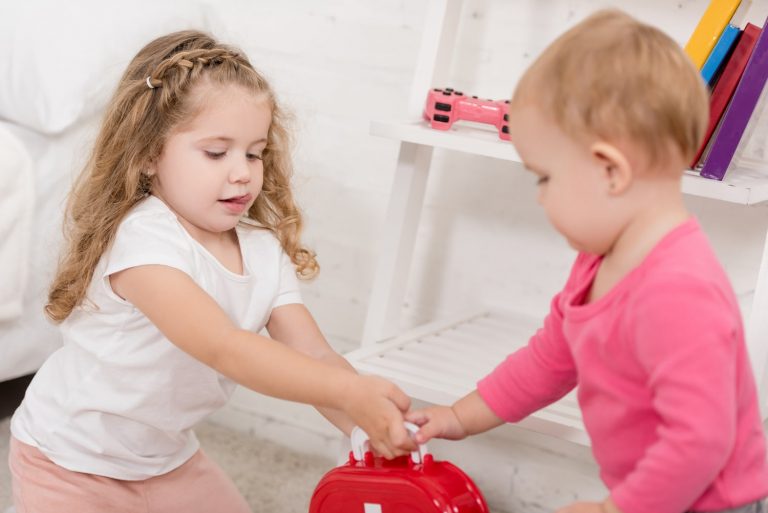Developmental milestones are a helpful and informative way to determine if your child is developing as expected. As a parent, it can be overwhelming and difficult to gauge what your child should be able to do and by when. In fact, it can be discouraging when you see same-aged peers developing at a different rate.
In our past blog posts, we explored important developmental milestones for children at 2 years of age. You’ve officially passed the “terrible two” phase and your child is turning three! By 3 years old, your child is getting bigger and showing more independence day by day. Your 3-year old is forming perceptions of the world around them and is more curious to explore their surroundings.
Feel free to use the milestones below as a guide to help you determine what to expect next and if your child is meeting their milestones.

Communication Milestones
With each day that passes, your child is experiencing a HUGE GROWTH of language. Your child may be talking more and attempting to communicate their wants and needs more frequently. You may encounter more tantrums than when they were 2 years old since they are exhibiting more independence.
Check out what speech and language milestones you can expect from a 3-year old.
- Your child is starting to use the prepositions "in", "on", and "under".
- Your child able to combine 2-3 words to communicate wants and needs.
- Your child is starting to answer wh- questions (e.g. who is this, what is that).
- Your child can produce the following sounds clearly: /k/, /g/, /f/, /t/, /d/, and /n/.
- Your child can use present progressive -ing ("running") and possessive 's.
- Your child is learning new words everyday and my be imitating you more.
- Your child is starting to learn opposites (big vs. small).
- Your child can follow 2-step directions.
- Your child can answer yes and no questions.
- Your child can understand the concepts of "all" and "one" ("put all the marbles in the bag").
- Your child can understand the pronouns "me", "my", and "your".
Movement Milestones (Motor)
Your child’s motor skills are quickly developing as well. It’s crazy to think how your little one went from crawling, to their first steps, to know running around the home exploring the world around them.
Check out what motor milestones you can expect from a 3-year old.
- Your child is starting to climb.
- Your child is running around.
- Your child can walk up and down the stairs with one foot at a time.
- Your child can pedal. Many children start learning how to ride a tricycle.
- Your child enjoys jumping and can jump with one foot or two feet.
- Your child can kick and catch a ball.
- Your child is starting to use age-appropriate scissors.
- Your child can turn pages in a book.
- Your child can build a tower with blocks.
- Your child can also dress and undress themself with some help.
Play Milestones
As your child starts to explore the world around them, he will be more social towards others as he takes a stronger interest in those around him.
Check out what play milestones you can expect from a 3-year old.
- Your child is starting play with others.
- When engaging with peers, your child may demonstrate turn-taking.
- Your child can show affection towards others.
- Your child will imitate your words and actions more frequently.
- Your child loves to engage in pretend play.
What Can I Do To Help?
If you notice that your child is not demonstrating some of the milestones above, try these helpful suggestions below.
- Allow your child choices. Previously, your child may have pointed or pulled you toward an object to have you retrieve it. With their language growing expansively, try to give them an option of 2 so they have to use their words to make a choice. Giving them an option also helps increase their independence.
- Read to your child. Some popular books that I love to read are “Brown Bear Brown Bear: What Do You See” and “Chicka Chicka Boom Boom“. These are great books because they often repeat to help your child feel included and entices them to join along.
- Expand on their words. At this point, your child is communicating in 2-3 word phrases. Continue to build on their phrases. For example if your child says “pink flower”, you can respond “yes, that is a pretty flower. It’s pink and red. Do you want to hold the flower?”
- Limit exposure to screen time. In my past post, I dived into the literature to determine if screen time impacted speech and language development. At age 3, it is highly recommended to limit screen time to 1 hour per day with frequent active engagement with an adult while watching.
If you still feel that your child is not meeting their milestones appropriately, please a consultation below so we can determine if your child would benefit from comprehensive evaluation.
References
American Speech Language Hearing Association. Two to Three Years. American Speech Language Hearing Association. Accessed 23 February 2022. https://www.asha.org/public/speech/development/23/
Marks, Hedy. 3 to 4 year old Developmental Milestones. Grow by WebMD, 19 December 2020. Accessed 23 February 2022. https://www.webmd.com/parenting/3-to-4-year-old-milestones/
